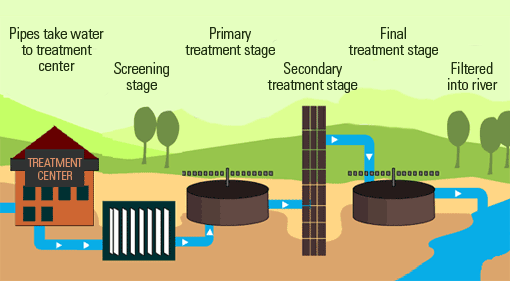Strategic Approaches to Boost Drainage Therapy Performance and Minimize Environmental Effect
In the world of drainage therapy, the quest for enhanced efficiency and minimized ecological influence is a continuous challenge that demands calculated remedies. As society grapples with the vital to take care of water resources sustainably, a nuanced approach ends up being crucial. The integration of sophisticated treatment technologies, energy-efficient processes, source recuperation strategies, enhanced nutrient elimination strategies, and clever monitoring and control systems represents a diverse structure for dealing with these pressing concerns. What lies at the core of this facility internet of methods is the prospective to transform the way we come close to waste water therapy, not simply as a procedure of disposal, however as an important opportunity for development and environmental stewardship.
Advanced Therapy Technologies
Advanced membrane filtering systems have actually revolutionized innovative wastewater therapy procedures, significantly enhancing the removal of contaminants. This innovation has verified to be extremely effective in getting rid of a vast array of impurities, consisting of drugs, heavy steels, and natural substances, which are often testing to remove via traditional treatment approaches.
Moreover, membrane layer purification systems supply countless benefits over traditional treatment approaches. They call for much less area, produce higher-quality effluent, and are more resistant to variations in influent water high quality. Furthermore, these systems are highly versatile and can be conveniently incorporated into existing treatment plants or made use of as standalone systems for decentralized applications. As the demand for tidy water proceeds to rise, the fostering of innovative membrane layer filtering technologies is vital to make certain lasting and efficient wastewater treatment techniques.
Energy-Efficient Procedures
The assimilation of energy-efficient procedures in wastewater treatment systems is critical for optimizing resource use and reducing operational expenses. One key method to boosting power performance in wastewater therapy is the utilization of sophisticated aeration systems, such as great bubble diffusers or surface area aerators, which can boost oxygen transfer performance and reduce energy consumption.
Additionally, maximizing procedure control and automation via making use of sophisticated sensing units and monitoring systems can improve general power performance by readjusting procedures in real-time based on actual demand and conditions. Executing energy audits and consistently monitoring power performance indicators are important methods to identify locations for renovation and track energy-saving campaigns successfully. Generally, the adoption of energy-efficient processes in wastewater treatment not just profits the environment but also adds to long-lasting expense savings and operational sustainability.
Source Healing Strategies
With a concentrate on optimizing source usage and sustainability in wastewater treatment systems, the implementation of source recuperation techniques arises as a crucial facet in improving operational performance. Source recovery approaches in wastewater therapy involve the recognition and extraction of beneficial resources from the waste stream, thereby transforming what was once considered waste right into an important property. By executing source healing techniques such as nutrient elimination and recovery, power generation from organic issue, and the production of multiple-use water, wastewater treatment plants can decrease environmental influence while making the most of efficiency.

Boosted Nutrient Elimination Methods
Executing advanced nutrient elimination strategies is necessary for enhancing the efficiency of wastewater therapy systems. Boosted nutrient removal plays an important role in decreasing the ecological effect of treated effluent released into visit water bodies. One of the vital strategies utilized for enhanced nutrient elimination is the process of organic nutrient elimination (BNR), which includes the elimination of nitrogen and phosphorus with biological procedures. This can be accomplished via making use of specialized microorganisms that can transform nitrogen compounds right into inert nitrogen gas with denitrification, and accumulate phosphorus within their cells via a process called improved biological phosphorus elimination (EBPR)

In enhancement to BNR, advanced treatment techniques such as membrane bioreactors (MBRs) and built wetlands can likewise be utilized to enhance nutrient removal efficiency. By integrating these advanced nutrient removal techniques right into wastewater therapy municipalities, systems and sectors can successfully decrease nutrient pollution and safeguard the environment.
Smart Tracking and Control Solution
Utilizing advanced innovation, the integration of smart surveillance and control systems reinvents the operational efficiency of wastewater therapy facilities. These systems include sophisticated sensors and information analytics to constantly monitor vital specifications such as pH levels, turbidity, liquified oxygen, and circulation rates in real-time. By accumulating and examining this data, drivers can acquire beneficial insights right into the performance of the therapy processes, making it possible for positive changes to enhance therapy effectiveness.
Smart surveillance and control systems likewise sustain remote monitoring abilities, allowing operators to accessibility real-time data and control features from off-site locations. This remote availability enhances operational adaptability and responsiveness, enabling speedy interventions in situation of system breakdowns or changes in influent top quality. The anticipating maintenance abilities of these systems aid avoid tools failures and lessen downtime, inevitably enhancing the general integrity of wastewater therapy procedures.
Conclusion
To conclude, critical strategies such as innovative treatment technologies, energy-efficient processes, resource healing methods, boosted nutrient elimination strategies, anchor and smart monitoring and control systems play a critical duty in enhancing wastewater therapy efficiency and reducing ecological impact. By executing these strategies, wastewater therapy plants can boost their overall performance, decrease power usage, recuperate beneficial sources, and ensure compliance with ecological laws. These strategies are essential for reliable and lasting wastewater administration practices.

In conclusion, tactical strategies such as advanced therapy technologies, energy-efficient processes, source recovery methods, boosted nutrient removal methods, and clever monitoring and control systems play a crucial function in improving wastewater therapy performance and decreasing ecological effect.